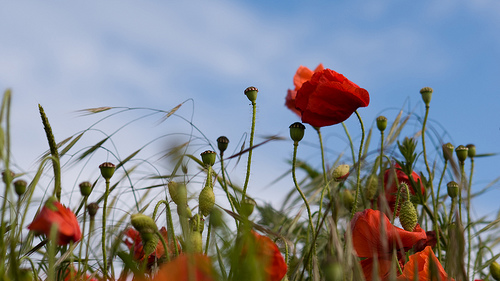by Michelle Sutton-Kerchner
On bright, beautiful days, there may be times you want to enjoy an outdoor workout. Don’t rush out without these precautions in mind …
Changing your workout routine on a regular basis keeps the body challenged and the mind engaged. A change in scenery can also be helpful. Migrating from the Group Fitness studio to the Exercise Floor or Pilates studio assures all the requirements for an effective workout are met. It is also fun to take advantage of the pleasant weather. A summer backdrop for your routine can enhance your Center programs.
Motivate yourself with sunshine and fresh air. Keep it healthy though. Don’t undo the benefits of an exhilarating workout. Avoid health hazards common to fitness alfresco.
Airborne

Environmental issues can have serious effects on your fitness level. Air pollution from vehicles, construction sites, fuels, factories, and the diminished ozone lodge in the respiratory system of frequent outdoor exercisers. Working out in these conditions is especially harmful. During a fitness routine, deep breaths are inhaled, often through the mouth. Large gulps of air enter the body with minimal filtering since it bypasses nasal passages and the upper respiratory tract.
Respiratory irritation slows down progress and continues to have a negative impact on performance, even days later. Both stamina and speed diminish as lungs continue to suffer from inflammation. One study noticed a 5-percent reduction in distance capacity three days after exercise in a congested environment.
Beyond a stalled workout, exercising in a polluted environment also has adverse effects on your health. Long-term exposure can cause lung damage equivalent to that of cigarette smoke. The Physician and Sportsmedicine published a study on participants who ran 30 minutes alongside a congested New York City road. This resulted in blood-toxin levels similar to those found in regular smokers.
Frequent workouts in highly polluted areas may increase your risk of heart disease, cardiac events, high blood pressure, and asthma. According to the Journal of the American Medical Association, it can raise risk of lung cancer to that of secondhand-smoke exposure. Pollution can actually negate the health benefits exercise usually has on the lungs. You don’t have to be asthmatic to feel the effects. Even those in the best health with optimum cardio capacity may find themselves gasping for air as the ozone’s effects diminish their workout.
For those with asthma, an outdoor workout may put one at risk for an attack. You are faced with allergy-induced and exercise-induced triggers, simultaneously. For more on exercising with asthma, visit: https://fitnessandwellnessnews.com/breathe-easy-you-can-exercise-with-asthma-allergies (F&W News, April 23, 2010).
Solution
If the outdoors is calling you, answer. However, you don’t have to respond with a high-impact workout. Save intense cardio routines for the comfort of the Center where the environment is “smooth,” both for your joints and lungs. Perform your add-on exercises outdoors: enjoy a walk, some one-on-one in the confines of a court, or a leisure bike ride. Low-impact activity requires less stress on the respiratory system, which may be compromised when air quality is poor.

Sign up for e-mail updates from the Environmental Protection Agency (EPA) to inform you of the local daily Air Quality Index. Visit www.airnow.gov. Exercise upwind to minimize exposure to pollen and pollution. Try to avoid congested areas. There is incongruity in the jogger who runs along a fume-filled highway. That doesn’t register high on the health index.
Land & Water Culprits
Pollution is not the only factor. Fertilizers, insecticides, and pesticides found everywhere, from lawns and playgrounds to local farms, affect our breathing. They can also be absorbed through skin. A simple neighborhood walk can have you accumulating particles of overspray from lawn treatments. Often, the greenest lawns got that way through chemicals. Despite today’s eco-friendly products, there are still concerns.

That which covers the ground is connected to our water sources. The earth knows how to recycle– absorbing and reabsorbing, overflowing. Unfortunately, agricultural runoff from fertilizers and pesticides, industrial waste, and sewage often cycles into natural water bodies like lakes, rivers, bays, and streams. High pollution has resulted in beaches toxic enough to close for several days. Swimmers need to beware. Such conditions can cause gastrointestinal problems, rashes, infections, and hepatitis.
Many exercisers spray on insect repellent. Although wise in the battle against ticks and mosquitoes, the most effective of these repellents often contain harsh chemicals.
Solution
Try to plan golf outings and field excursions around scheduled fertilization and pesticide treatments. Allow 24 hours after applications before using. For personal use, use non-toxic “green” products. Retail shelf space continues to grow for organic and green brands. Do your part and choose these. This includes insect repellents. Progress is being made in developing effective solutions that remain easy on the skin. Regardless, always wash well after coming indoors to remove any residual.
Wear goggles when swimming, especially in natural bodies of water. Keep your mouth closed to avoid accidentally swallowing impurities. Water conditions for the shore can be found on the Internet at the EPA’s BEACON (Beach Advisory and Closing Online Notification). Although rain helps clear air pollution, it often has the reverse affect on swim conditions. Heavy rain can cause sewage overflow and storm runoff, which contaminates swim areas. Try to avoid water activities for 24 hours after a heavy storm; 72 hours before swimming in lakes and lagoons. Rinse your suit and shower immediately after water activity.
Pool water should be properly monitored throughout the day. The Centers for Disease Control and Prevention report an alarming number of pools as being contaminated by e-coli, which can cause everything from eye irritation and sore throat to long-term gastrointestinal issues. Be sure to shower before and after public pool use to cut down on the spread of bacteria, for yourself and others. Make frequent bathroom trips with little ones, regardless of requests. The Center pools are continuously monitored and properly treated by certified pool operators. Be sure your summer swim locales practice the same diligence.
Allergens
On high pollen days, even those without allergies can be affected by air quality. Particles of any nature floating in the air can cause irritation to the throat, sinuses, and respiratory tract. Even the most allergic may have times when their inner athlete channels them to a neighbor’s volleyball game or provokes them to join an outdoor sporting event. Before you sneeze yourself off the field, try these tips:
- Don’t forget to warm-up. The American Academy of Allergy, Asthma & Immunology indicates warm-ups help reduce allergic symptoms. Spend approximately ten minutes stretching and boosting cardio for full benefit.
- Take note of your surroundings. For someone allergic to weeds and grass pollens, playing tennis on a campus field surrounded by dandelions isn’t recommended. If you suffer from molds, don’t toss a Frisbee lakeside.
- Try wearing a mask to filter pollen and pollution for those outdoor walks. Sunglasses protect eyes from airborne allergens as well as ultraviolet rays.
- Check the daily pollen and mold counts for your area (easily found at www.weather.com). Schedule outdoor activities around the peak times. Phone apps are available that send pollen count updates to your phone, with alerts specific to your allergy.
- Avoid outdoor excursions on hot, windy days, which literally blow countless allergens through the air.
- Beware of thunderstorms. Asthmatic reactions tend to peak after these for some sufferers, according to research based on hospital emergency department treatments.
 The facts may sound daunting, but there are solutions. Although some experts are concerned about the overall health of regular outdoor exercisers, knowledge is power. Adjust your workout, based on awareness of health hazards and how to avoid them. Studies have proven regular exercise can help contain allergies and improve respiratory function. Physical activity results in strong blood flow. This allows toxins to be moved quickly through the body and eliminated via the kidneys and skin.
The facts may sound daunting, but there are solutions. Although some experts are concerned about the overall health of regular outdoor exercisers, knowledge is power. Adjust your workout, based on awareness of health hazards and how to avoid them. Studies have proven regular exercise can help contain allergies and improve respiratory function. Physical activity results in strong blood flow. This allows toxins to be moved quickly through the body and eliminated via the kidneys and skin.
Take advantage of the pollen-free, filtered air within the Center. The temperature is always comfortable so you can turn up the heat on your workout without danger. Let activity in the Great Outdoors supplement your fitness routine. And for times Mother Nature cannot oblige–or you’re out of sunscreen, there is always the Center.
Sources
www.cdc.gov
www.everydayhealth.com
“The Dirty Secret of Outdoor Exercise,” by Karen Houppert at www.fitnessmagazine.com.
Images
Windy poppies: http://www.flickr.com/photos/petercastleton/3636817756
Cycler: http://www.flickr.com/photos/bike/5694468126
City jogger: http://www.flickr.com/photos/dno1967b/8492560318
Water pollution: http://www.flickr.com/photos/gambier20/3208414588/sizes/m/in/photostream/
Beach volleyball: www.flickr.com/photos/neo_ii/4916866338/
 Fitness & Wellness News Your Source for Fitness News, Wellness News, Health News, and Nutrition News!
Fitness & Wellness News Your Source for Fitness News, Wellness News, Health News, and Nutrition News!




